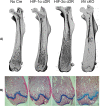Degradation-Resistant Hypoxia Inducible Factor-2α in Murine Osteocytes Promotes a High Bone Mass Phenotype
- PMID: 37065633
- PMCID: PMC10097640
- DOI: 10.1002/jbm4.10724
Degradation-Resistant Hypoxia Inducible Factor-2α in Murine Osteocytes Promotes a High Bone Mass Phenotype
Abstract
Molecular oxygen levels vary during development and disease. Adaptations to decreased oxygen bioavailability (hypoxia) are mediated by hypoxia-inducible factor (HIF) transcription factors. HIFs are composed of an oxygen-dependent α subunit (HIF-α), of which there are two transcriptionally active isoforms (HIF-1α and HIF-2α), and a constitutively expressed β subunit (HIFβ). Under normoxic conditions, HIF-α is hydroxylated via prolyl hydroxylase domain (PHD) proteins and targeted for degradation via Von Hippel-Lindau (VHL). Under hypoxic conditions, hydroxylation via PHD is inhibited, allowing for HIF-α stabilization and induction of target transcriptional changes. Our previous studies showed that Vhl deletion in osteocytes (Dmp1-cre; Vhl f/f ) resulted in HIF-α stabilization and generation of a high bone mass (HBM) phenotype. The skeletal impact of HIF-1α accumulation has been well characterized; however, the unique skeletal impacts of HIF-2α remain understudied. Because osteocytes orchestrate skeletal development and homeostasis, we investigated the role of osteocytic HIF-α isoforms in driving HBM phenotypes via osteocyte-specific loss-of-function and gain-of-function HIF-1α and HIF-2α mutations in C57BL/6 female mice. Deletion of Hif1a or Hif2a in osteocytes showed no effect on skeletal microarchitecture. Constitutively stable, degradation-resistant HIF-2α (HIF-2α cDR), but not HIF-1α cDR, generated dramatic increases in bone mass, enhanced osteoclast activity, and expansion of metaphyseal marrow stromal tissue at the expense of hematopoietic tissue. Our studies reveal a novel influence of osteocytic HIF-2α in driving HBM phenotypes that can potentially be harnessed pharmacologically to improve bone mass and reduce fracture risk. © 2023 The Authors. JBMR Plus published by Wiley Periodicals LLC on behalf of American Society for Bone and Mineral Research.
Keywords: GENETIC ANIMAL MODELS; OSTEOCLAST; OSTEOCYTE.
© 2023 The Authors. JBMR Plus published by Wiley Periodicals LLC on behalf of American Society for Bone and Mineral Research.
Conflict of interest statement
All authors declare that they have no relevant or material financial interests that relate to the research described in this paper.
Figures






Similar articles
-
Hypoxia-Inducible Factor-2α Signaling in the Skeletal System.JBMR Plus. 2023 Feb 26;7(4):e10733. doi: 10.1002/jbm4.10733. eCollection 2023 Apr. JBMR Plus. 2023. PMID: 37065626 Free PMC article. Review.
-
Osteocytic oxygen sensing: Distinct impacts of VHL and HIF-2alpha on bone integrity.Bone. 2025 Mar;192:117339. doi: 10.1016/j.bone.2024.117339. Epub 2024 Nov 26. Bone. 2025. PMID: 39603372
-
Vhl deficiency in osteocytes produces high bone mass and hematopoietic defects.Bone. 2018 Nov;116:307-314. doi: 10.1016/j.bone.2018.08.022. Epub 2018 Aug 30. Bone. 2018. PMID: 30172741
-
Up-regulation of hypoxia-inducible factors HIF-1alpha and HIF-2alpha under normoxic conditions in renal carcinoma cells by von Hippel-Lindau tumor suppressor gene loss of function.Oncogene. 2000 Nov 16;19(48):5435-43. doi: 10.1038/sj.onc.1203938. Oncogene. 2000. PMID: 11114720
-
Update on mutations in the HIF: EPO pathway and their role in erythrocytosis.Blood Rev. 2019 Sep;37:100590. doi: 10.1016/j.blre.2019.100590. Epub 2019 Jul 16. Blood Rev. 2019. PMID: 31350093 Free PMC article. Review.
Cited by
-
Blood routine test-based biomarkers is related to bone mineral density in elderly patients with chronic heart failure: A retrospective study.Medicine (Baltimore). 2024 Dec 13;103(50):e40946. doi: 10.1097/MD.0000000000040946. Medicine (Baltimore). 2024. PMID: 39686434 Free PMC article.
-
Pharmacological inhibition of HIF2 protects against bone loss in an experimental model of estrogen deficiency.Proc Natl Acad Sci U S A. 2024 Dec 3;121(49):e2416004121. doi: 10.1073/pnas.2416004121. Epub 2024 Nov 27. Proc Natl Acad Sci U S A. 2024. PMID: 39602268 Free PMC article.
-
Oxygen Sensing in Osteocytes: From Physiology to Age-related Osteoporosis.Curr Osteoporos Rep. 2025 Jun 21;23(1):28. doi: 10.1007/s11914-025-00920-7. Curr Osteoporos Rep. 2025. PMID: 40542900 Review.
-
Hypoxia-Inducible Factor-2α Signaling in the Skeletal System.JBMR Plus. 2023 Feb 26;7(4):e10733. doi: 10.1002/jbm4.10733. eCollection 2023 Apr. JBMR Plus. 2023. PMID: 37065626 Free PMC article. Review.
-
Lipolysis products from triglyceride-rich lipoproteins induce stress protein ATF3 in osteoblasts.J Orthop Res. 2024 May;42(5):1033-1044. doi: 10.1002/jor.25756. Epub 2023 Dec 21. J Orthop Res. 2024. PMID: 38044472 Free PMC article.
References
-
- Kaelin WG, Ratcliffe PJ. Oxygen sensing by metazoans: the central role of the HIF hydroxylase pathway. Mol Cell. 2008;30(4):393‐402. - PubMed
Grants and funding
LinkOut - more resources
Full Text Sources
Molecular Biology Databases
